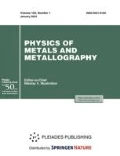Abstract
Specific features of nuclear magnetic resonance (NMR) in a ferromagnet with a crystallographic magnetic anisotropy of the easy-plane type placed in a constant magnetic field have been studied. The symmetry of the magnet admits the existence of the Dzyaloshinskii-Moriya interaction, which leads to the formation of a new ground state, namely, a soliton lattice (spiral structure). Within the spin-wave approximation, the following basic local characteristics of the NMR of this structure have been calculated: resonance frequency, enhancement factor, and line broadening and their field dependences have been investigated. The magnetic resonance susceptibility of the electron-nucleus spin system has been calculated; the shape of the NMR absorption line has been analyzed. The problem of the evolution of the NMR absorption line upon the change in the magnitude of an external magnetic field has been solved. The possibility of the experimental detection and investigation of the structural and dynamic features of the spiral magnetic structure by the NMR method is discussed.
Similar content being viewed by others
References
Yu. A. Izyumov, Neutron Diffraction on Long-Period Structures (Atomizdat, Moscow, 1987) [in Russian].
T. K. Soboleva, E. P. Stefanovskii, and V. V. Tarasenko, “Equilibrium state and elementary excitations in magnets with inhomogeneous exchange-relativistic interaction in an external magnetic field,” Fiz. Tverd. Tela 22, 2353–2359 (1980).
Y. Togava, S. Mori, Y. Kousaka, J. Akimitsu, S. Nishihara, K. Inoue, A. S. Ovchinnikov, and J. Kishine, “Chiral magnetic soliton lattice on chiral helimagnet,” Phys. Rev. Lett. 108, 107202 (2012).
E. A. Turov, Physical Properties of Magnetically Ordered Crystals. Phenomenological Theory of Spin Waves in Ferromagnets, Antiferromagnets and Weak Ferromagnets (Akad. Nauk SSSR, Moscow, 1963) [in Russian].
E. A. Turov and M. P. Petrov, Nuclear Magnetic Resonance in Ferro- and Antiferromagnets (Nauka, Moscow, 1969) [in Russian].
V. N. Sedyshkin and A. P. Tankeev, “Peculiarities of nuclear magnetic resonance in ferromagnets with 360° domain walls,” Fiz. Met. Metalloved. 67, 1068–1075 (1989).
E. A. Turov, A. P. Tankeev, and M. I. Kurkin, “To the theory of nuclear magnetic resonance susceptibility of multidomain ferromagnets. I. Analysis of local frequencies,” Fiz. Met. Metalloved. 28, 385–401 (1969).
M. I. Kurkin and A. P. Tankeev, “Effects of amplification and dynamical shift of nuclear magnetic resonance frequencies and their connection with magnetic local properties,” Fiz. Met. Metalloved. 42, 915–930 (1976).
E. A. Turov and M. I. Kurkin, “To the theory of nuclear magnetic resonance susceptibility of magnetic substances,” Fiz. Tverd. Tela 10, 3222–3232 (1968).
M. I. Kurkin and E. A. Turov, Nuclear Magnetic Resonance in Magnetically Ordered Substances and Its Application (Nauka, Moscow, 1990) [in Russian].
E. A. Turov, A. P. Tankeev, and M. I. Kurkin, “To the theory of nuclear magnetic resonance susceptibility of multidomain ferromagnetic. II. Local coefficient of amplification and integral susceptibility,” Fiz. Met. Metalloved. 29, 747–756 (1970).
G. A. Murray and W. Marshall, “A new interpretation of nuclear magnetic resonance in dilute ferromagnetic alloys,” Proc. Phys. Soc. 86, 315–330 (1965).
M. A. Butler, “Wall resonances in ferromagnets,” Int. J. Magn. 34, 131–138 (1973).
M. A. Butler, “Domain wall enhanced NMR in anisotropic ferromagnets,” J. Phys. Soc. Jpn. 34, 1419–1420 (1973).
A. V. Zalesskii, A. M. Savinov, I. S. Zheludev, and A. N. Ivashchenko, “Nuclear magnetic resonance on 57Fe nuclei and spin reorientation in domains and domain boundaries of ErFeO3 and DyFeO3 crystals,” Zh. Eksper. Teor. Fiz. 68, 1449–1459 (1975).
A. V. Zalesskii, A. K. Zvezdin, A. A. Frolov, and A. A. Bush, “57Fe nuclear magnetic resonance study of a spatially modulated magnetic structure in BiFeO3,” JETP Lett. 71, 465–468 (2000).
A. V. Zalesskii, A. A. Frolov, T. A. Khimich, and A. A. Bush, “Composition-induced transition of spinmodulated structure into a uniform antiferromagnetic state in a Bi1 − x LaxFeO3 system studied using 57Fe nuclear magnetic resonance,” Phys. Solid State 45, 141–145 (2003).
A. B. Borisov, J. Kishine, I. G. Bostrem, and A. S. Ovchinnikov, “Magnetic soliton transport over topological spin texture in chiral helimagnet with strong easy-plane anisotropy,” Phys. Rev. B: Condens. Matter Mater. Phys. 79, 134436 (2009).
N. J. Ghimire, M. A. McGuire, D. S. Parker, B. Sipos, S. Tang, J.-Q. Yan, B. C. Sales, and D. Mandrus, “Magnetic phase transition in single crystals of the chiral helimagnet Cr1/3NbS2,” Phys. Rev. B: Condens. Matter Mater. Phys. 87, 104403 (2013).
C.H. Cobb, V. Jaccarino, M. A. Butler, J. P. Remeika, and H. Yasuoka, “Low temperature 53Cr nuclear magnetic resonance in ferromagnetic single CrBr3 crystal,” Phys. Rev. B 7, 307–318 (1973).
A. V. Zalesskii, A. A. Frolov, A. K. Zvezdin, A. A. Gippius, E. H. Morozova, D. F. Khozeev, A. S. Bush, and B. C. Pokatilov, “Effect of spatial spin modulation on the relaxation and nuclear magnetic resonance frequencies of 57Fe nuclei in a ferroelectric antiferromagnet BiFeO3,” J. Exper. Theor. Phys. 95, 101–105 (2002).
Author information
Authors and Affiliations
Corresponding author
Additional information
Original Russian Text © A.P. Tankeyev, M.A. Borich, V.V. Smagin, 2014, published in Fizika Metallov i Metallovedenie, 2014, Vol. 115, No. 3, pp. 248–259.
Rights and permissions
About this article
Cite this article
Tankeyev, A.P., Borich, M.A. & Smagin, V.V. Nuclear magnetic resonance in magnets with a spiral magnetic structure. Phys. Metals Metallogr. 115, 232–242 (2014). https://doi.org/10.1134/S0031918X14030119
Received:
Published:
Issue Date:
DOI: https://doi.org/10.1134/S0031918X14030119


